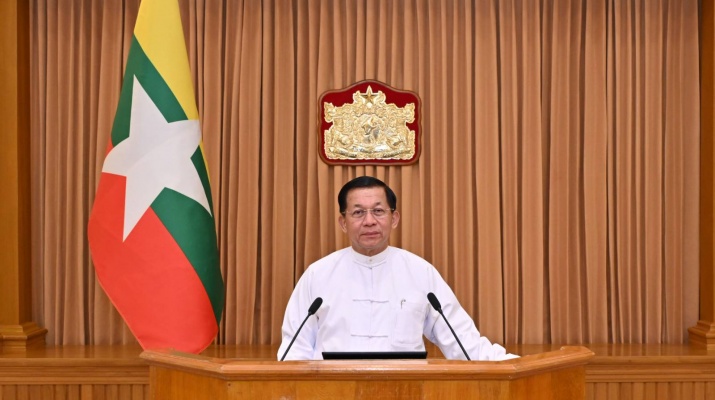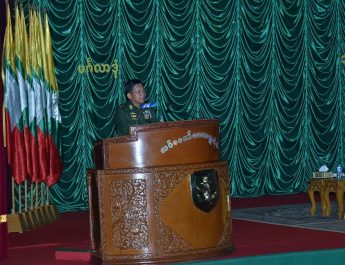8 March 2024
Everybody, Mingalabar!
First and foremost, I extended my greetings with best wishes for all distinguished guests attending the ceremony to mark the International Women’s Day 2024 to enjoy physical and mental pleasure with all auspiciousness.
Today, 8 March is designated as the International Women’s Day honoring the women worldwide.
Hence, global countries celebrate the ceremony to mark the International Women’s Day for further emphasizing the rights and capacity of women and deeply implementing development of women with acceleration on a yearly basis.
This year’s theme for the International Women’s Day has been set as Invest in Women: Accelerate Progress. In accord with the theme, I would like to urge everyone to explore the best ways and means for women and girls to have a greater chance to participate in the economic sector, while also ensuring access to education and health facilities, in order to eliminate gender discrimination.
Currently, the theme of such significant day motivates all global countries to notice that although the international community can enhance all sectors, the women are considerably facing tremendous difficulties to participate in the economic sector in equal term of men. On the other hand, the theme spotlights that if women and girls have equal rights with men in education, health, job opportunities, financial services and literacy, they will be sure to enjoy gender equality.
It can be said that fulfilling the needs of women and girls to enhance their capacity and helping them strengthen capabilities of studies, earning incomes and leadership can be defined as good investments for the future.
Since 2020, COVID-19 pandemic, geopolitical conflicts, natural disasters and economic instabilities have been pushing more than 75 million global population into the poverty.
Reportedly, if nobody conducts necessary response to such a situation, more than 342 million of women and girls worldwide would lead under the poverty line in 2030.
Today’s majority of Myanmar females are capable of shouldering with males not only in families and societies but in all measures including political, economic, peaceful and societal development. As such, it is necessary to take the strength of women to allow them to participate in the necessary sectors in order to modernize the country.
The literacy is playing a pivotal role in capacity enhancement of women. According to the surveys, women’s literacy rate worldwide scored 73.9 percent in 2000, compared with 82.7 percent in 2020. The literacy rate of women in ASEAN region accounted for 89.7 percent in 2000 but surged to 95.1 percent in 2023. In Myanmar, women’s literacy rate reached 73 percent in 2000 but 85 percent in 2023.
It is necessary to invest in education sector for women residing not only in urban but in rural areas and provide for girls and women who missed chance to learn school education to learn vocational courses in order to stand tall in the community with their livelihoods.
If so, they will be capable of independently operate own businesses so as to develop women’s economic sector starting from the manageable-scale businesses.
According to the gender based job opportunity survey worldwide (2023), number of males who secured employment scored 66.57 percent in 2020 and female 43.02 percent but number of males who grasped employment reached
67.86 percent in 2023 and female 43.82 percent. It shows a gap between employment situations between male and female.
As such, the government is implementing the plans for development of micro-, small and medium-scale enterprises (MSMEs) in which the majority of women can participate with enhancement of necessary skills. The Social Security Law has been enacted to establish nursery units at factories and workplaces formed with more than 100 female workers for enabling women without any worries about family affairs.
As technology is crucial in job opportunities and businesses at present, women have to be capable of applying technology in conformity with the modern era. Surveys stated that a total of 27 percent women population of the global people are taking part in the technology-applied workplaces and 20 more percent of women are taking a leading role in the technological sector. Although there is no data of women who participate in the technology-prone workplaces in Myanmar, female students accounting for 48 percent of all students are attending technological universities and universities of computer studies.
So, the government arranges equal terms of rights for women to join the employment opportunities concerning engineering, technologies and computer sciences without gender discrimination. It is necessary to conduct the digital literacy courses for women to be able to apply technology. At present, the Department of Advanced Science and Technology under the Ministry of Science and Technology conducts the human resource development courses and technological enhancement courses. Recruitment of trainees does not discriminate gender, and if they are in conformity with designated criteria, both male and female can join the training courses.
Hence, it is necessary to arrange plans for women to participate in the training courses.
Moreover, the second term (2023-2032) of the national strategic plan for development of women is being drafted for enhancement of women’s capacity in the country, and when it has been approved, relevant ministries and organizations have to cooperate in implementation of the plan.
In accord with the statistics based on the 2014 population and housing census released on 1 October 2023, a total of 56.2 million population of Myanmar comprises 26.8 million population of men and 29.4 million population of women who accounts for more than 52 percent. The Union report of 2019 interim census mentioned 72.5 percent of literacy rate of people across the Union above 25 years old at the middle school level consisting of 73.6 percent for women and 72.4 percent for men. The workable people scored 63.2 percent nationwide, comprising 75.7 percent of men and 52.7 percent of men. The unemployment rate across the Union hit 2.7 percent, including 2.1 percent of men and 3.4 percent of women. Moreover, the total population of the Union bears 61.5 percent of employed persons, comprising 74.1 percent of men and 50.9 percent of women. The detail clarification will be wider. Such factors show it is necessary to enhance the role of women. Hence, we have to make arrangements for women to have greater chance to participate in the political,
economic, peaceful and societal development undertakings with momentum based on strength of women.
In conclusion, I would like to urge those in private sector, nongovernmental organizations, civil society organizations and entire people to harmoniously cooperate with the government in invest in the women’s sector for its development in order to utilize the capacity of women who are more than a half strength of the Myanmar’s population and to have overall capacities in accord with this year’s theme “Invest in women: Accelerate progress”.
Thank you all.





